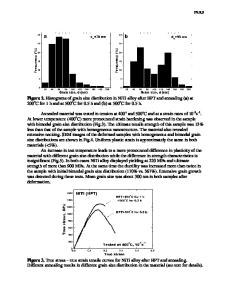Mechanical behavior of nanocrystalline Cu and Pd
- PDF / 1,667,141 Bytes
- 16 Pages / 576 x 792 pts Page_size
- 82 Downloads / 364 Views
R.W. Siegel Materials Science Division, Argonne National Laboratory, Argonne, Illinois 60439 (Received 30 July 1990; accepted 23 January 1991) This report gives results of a study of the bulk mechanical properties of samples of nanocrystalline Cu and Pd consolidated from powders prepared by inert gas condensation. Fourier analysis x-ray diffraction techniques, used to determine average grain size and mean lattice strains of the as-consolidated samples, show grain sizes in the range of 3-50 nm and lattice strains ranging from 0.02-3%. Sample densities range from 97-72% of the density of a coarse-grained standard. Microhardness of the nanocrystalline samples exceeds that of annealed, coarse-grained samples by a factor of 2-5, despite indications that sample porosity reduces hardness values below the ultimate value. Uniaxial tensile strength of the nanocrystalline samples is similarly elevated above the value of the coarse-grained standard samples. Restrictions on dislocation generation and mobility imposed by ultrafine grain size are believed to be the dominant factor in raising strength. Residual stress may also play a role. Room temperature diffusional creep, predicted to be appreciable in nanocrystalline samples, was not found. Instead, samples appear to show logarithmic creep that is much smaller than the predicted Coble creep.
I. INTRODUCTION Grain size is known to have a profound effect on the mechanical behavior of materials, in particular, on the yield stress and the diffusional creep rate. This effect has been well-studied for grain sizes down to about 1 fira. Study of mechanical effects for materials with smaller grain size has been limited by the difficulty of producing bulk materials with such grain sizes. The inert gas condensation process followed by in situ consolidation has recently been used1"7 to produce ultrafinegrained metals and ceramics with a narrow grain size distribution. By adjusting the synthesis conditions, the average grain size can be made to fall in the 5-50 nm size range. The present paper describes the results of a study of the mechanical behavior of bulk specimens of Cu and Pd made by cold compaction of nanocrystalline particles produced by this method. Uniaxial tensile stress-strain tests and constant load creep tests were performed at room temperature on bulk materials with grain sizes in the range of 5-50 nm; additional information was furnished by Vickers microhardness measurements. The results are related to material properties that include grain size and density, and to processing variables such as heat treatment and sample preparation. Related short reports have been given in Refs. 8 and 9. The dependence of tensile yield stress on grain size in metals and ceramics is well established for microme1012 http://journals.cambridge.org
ter and larger grain sizes. Yield stress ay, for materials with grain size d, is found to follow the Hall-Petch relation10-11: o-y = o-o + kd~m
(1)
where o-0 is the friction stress and k is a constant commonly interpreted to represent the stress n
Data Loading...











